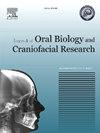Enhancing angiogenesis through secretomes: Insights from scratch wound assay
Q1 Medicine
Journal of oral biology and craniofacial research
Pub Date : 2025-06-02
DOI:10.1016/j.jobcr.2025.05.008
引用次数: 0
Abstract
Background
This study uses a scratch wound healing assay to investigate the angiogenic potential of secretomes derived from dental mesenchymal stem cells (DMSCs). Angiogenesis, defined as the process of generating new blood vessels, plays a pivotal role in the mechanisms of tissue regeneration and repair.
Methodology
We cultured DMSCs under standard conditions, collected the secretomes, and applied them to human endothelial cells cultured in a scratch-assay setup. Endothelial cell migration into the scratch area was observed and quantified over a 48-h period. Results were compared to controls treated with a standard growth medium.
Results
Preliminary findings indicate that DMSC-derived secretomes of dental pulp significantly enhance the migration of endothelial cells compared to controls, suggesting a strong angiogenic potential.
Conclusion
These findings show that DMSC secretomes from dental pulp can help with angiogenesis. This could have big effects on the development of new treatments for tissue repair and regeneration. This study provides valuable insights into the paracrine mechanisms through which DMSCs may contribute to angiogenesis, highlighting their potential in regenerative medicine applications.
通过分泌物组促进血管生成:从划伤试验的见解
本研究使用划伤愈合实验来研究牙间充质干细胞(DMSCs)分泌组的血管生成潜能。血管生成是指生成新血管的过程,在组织再生和修复机制中起着关键作用。方法:我们在标准条件下培养DMSCs,收集分泌组,并将其应用于在刮擦试验装置中培养的人内皮细胞。在48小时内观察并量化内皮细胞向划痕区域的迁移。结果与用标准培养基处理的对照进行了比较。结果初步发现,与对照组相比,dmsc衍生的牙髓分泌组显著增强了内皮细胞的迁移,表明其具有强大的血管生成潜力。结论牙髓DMSC分泌体具有促进血管生成的作用。这可能会对组织修复和再生新疗法的发展产生重大影响。这项研究为DMSCs促进血管生成的旁分泌机制提供了有价值的见解,突出了它们在再生医学中的应用潜力。
本文章由计算机程序翻译,如有差异,请以英文原文为准。
求助全文
约1分钟内获得全文
求助全文
来源期刊

Journal of oral biology and craniofacial research
Medicine-Otorhinolaryngology
CiteScore
4.90
自引率
0.00%
发文量
133
审稿时长
167 days
期刊介绍:
Journal of Oral Biology and Craniofacial Research (JOBCR)is the official journal of the Craniofacial Research Foundation (CRF). The journal aims to provide a common platform for both clinical and translational research and to promote interdisciplinary sciences in craniofacial region. JOBCR publishes content that includes diseases, injuries and defects in the head, neck, face, jaws and the hard and soft tissues of the mouth and jaws and face region; diagnosis and medical management of diseases specific to the orofacial tissues and of oral manifestations of systemic diseases; studies on identifying populations at risk of oral disease or in need of specific care, and comparing regional, environmental, social, and access similarities and differences in dental care between populations; diseases of the mouth and related structures like salivary glands, temporomandibular joints, facial muscles and perioral skin; biomedical engineering, tissue engineering and stem cells. The journal publishes reviews, commentaries, peer-reviewed original research articles, short communication, and case reports.
 求助内容:
求助内容: 应助结果提醒方式:
应助结果提醒方式:


